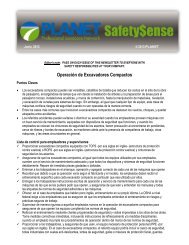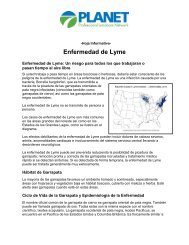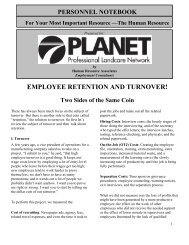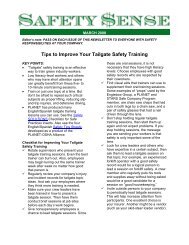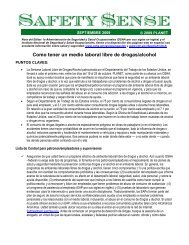Economic Impacts of the Green Industry in the - Urban Forest ...
Economic Impacts of the Green Industry in the - Urban Forest ...
Economic Impacts of the Green Industry in the - Urban Forest ...
You also want an ePaper? Increase the reach of your titles
YUMPU automatically turns print PDFs into web optimized ePapers that Google loves.
6. Results for <strong>the</strong> Wholesale and Retail Trade Sectors<br />
A total <strong>of</strong> seven sectors comprise <strong>the</strong> U.S. horticultural wholesale and retail trade <strong>in</strong>dustries: 1) wholesale flower,<br />
nursery stock & florist supply; 2) wholesale lawn & garden equipment; 3) retail lawn and garden supply stores; 4)<br />
retail build<strong>in</strong>g materials and supply stores; 5) florists; 6) retail food and beverage stores; and 7) retail general<br />
merchandise stores. The first two sectors are wholesale establishments that provide horticultural products and<br />
services to <strong>the</strong> retail sector, <strong>in</strong>clud<strong>in</strong>g plant material, chemical and fertilizer supplies, and various types <strong>of</strong> lawn<br />
and garden equipment. Retail lawn and garden supply stores are <strong>in</strong>dependent and cha<strong>in</strong> stores that sell primarily<br />
horticultural goods and services to end consumers. Retail build<strong>in</strong>g materials and supply stores are largely home<br />
improvement centers, such as Lowes, Home Depot, and Ace Hardware, all <strong>of</strong> which have lawn and garden<br />
centers. Retail food and beverage stores focus mostly on food items, but <strong>in</strong>creas<strong>in</strong>gly are <strong>in</strong>clud<strong>in</strong>g a floral section<br />
and seasonal landscape plant material. Examples <strong>of</strong> <strong>the</strong>se stores are Albertson’s, Publix, Safeway, W<strong>in</strong>n Dixie,<br />
and Kroger. The last category, retail general merchandise stores would <strong>in</strong>clude large cha<strong>in</strong> stores such as Wal-<br />
Mart and Target.<br />
Table 6-1 presents summary <strong>in</strong>formation on <strong>the</strong> number <strong>of</strong> establishments, paid employees, annual payroll, and<br />
output gross marg<strong>in</strong> for <strong>the</strong> seven <strong>in</strong>dustry sectors for horticultural goods. More than 116,000 establishments<br />
represent <strong>the</strong> wholesale and retail trade sectors. In terms <strong>of</strong> employment, two sectors accounted for 55 percent <strong>of</strong><br />
all employees (510,512) hired by <strong>the</strong> <strong>in</strong>dustry. The largest <strong>of</strong> <strong>the</strong>se was <strong>the</strong> retail lawn and garden supply stores<br />
which accounted for one third (171,149) <strong>of</strong> <strong>the</strong> total, followed by florists with nearly 113,929 (22 percent <strong>of</strong> <strong>the</strong><br />
total). Sectors with <strong>the</strong> smallest number <strong>of</strong> paid workers were <strong>the</strong> retail food and beverage stores, and wholesale<br />
lawn and garden equipment stores. Annual payroll ranged from a high <strong>of</strong> $3.9 billion for <strong>the</strong> retail lawn and<br />
garden supply stores to a low <strong>of</strong> $343 million for retail food and beverage stores. In terms <strong>of</strong> per capita<br />
compensation (annual payroll divided by number employees), <strong>the</strong> two wholesale sectors paid nearly double <strong>the</strong><br />
wages <strong>of</strong> <strong>the</strong> five retail sectors. Output gross marg<strong>in</strong>s varied from a high <strong>of</strong> $9.5 billion for retail lawn and garden<br />
supply stores to a low <strong>of</strong> $917 million for retail food and beverage stores. Output gross marg<strong>in</strong> generated per<br />
employee averaged $45,000 for all seven sectors, but ranged from a low <strong>of</strong> $25,000 for florists to a high <strong>of</strong><br />
$110,000 for wholesale lawn and garden equipment stores.<br />
Table 6-1. Output, Employment and Payroll <strong>in</strong> <strong>the</strong> U.S. Environmental Horticulture Wholesale<br />
and Retail Trade Sectors, 2002<br />
Output-<br />
<strong>Industry</strong> Sector<br />
Annual Gross<br />
Establishments<br />
Employees<br />
Paid<br />
Payroll Marg<strong>in</strong> on<br />
($Mn) Sales<br />
($Mn)<br />
Wholesale Flower, Nursery Stock & Florist Supply 4,816 60,010 1,645 2,094<br />
Wholesale Lawn & Garden Equipment 4,041 29,102 984 3,187<br />
Retail Lawn and Garden Supply Stores 21,065 171,149 3,922 9,503<br />
Retail Build<strong>in</strong>g Materials and Supply Stores * 18,623 60,450 1,673 4,108<br />
Florists 22,753 113,929 1,550 2,904<br />
Retail Food and Beverage Stores* 22,465 19,222 343 917<br />
Retail General Merchandise Stores Sector* 22,710 56,651 993 2,544<br />
Total Wholesale and Retail Trade 116,473 510,512 11,110 25,257<br />
*Estimated payroll and employment proportional to merchandise or product l<strong>in</strong>e sales as share <strong>of</strong> total sales.<br />
Sources: 2002 <strong>Economic</strong> Census (US Census Bureau)<br />
<strong>Economic</strong> impacts <strong>of</strong> <strong>the</strong> U.S. wholesale and retail trade sectors for horticultural goods are presented <strong>in</strong> Table 6-2.<br />
This <strong>in</strong>dustry group accounted for 37 percent <strong>of</strong> total output impacts <strong>of</strong> <strong>the</strong> U.S. <strong>Green</strong> <strong>Industry</strong>, and nearly half<br />
(47 percent) <strong>of</strong> all jobs. It also contributed over $35 billion <strong>in</strong> value added, represent<strong>in</strong>g 37 percent <strong>of</strong> <strong>the</strong> <strong>Green</strong><br />
<strong>Industry</strong> total. Of <strong>the</strong> seven sectors compris<strong>in</strong>g <strong>the</strong> wholesale and retail trade <strong>in</strong>dustry, retail lawn and garden<br />
supply stores were <strong>the</strong> most prom<strong>in</strong>ent, compris<strong>in</strong>g 42 percent <strong>of</strong> output impacts, 47 percent <strong>of</strong> all jobs, and<br />
pay<strong>in</strong>g 70 percent <strong>of</strong> all <strong>in</strong>direct bus<strong>in</strong>ess taxes. The second most important group was <strong>the</strong> retail build<strong>in</strong>g<br />
materials and supply stores, contribut<strong>in</strong>g nearly one-fifth <strong>of</strong> output impacts, 14 percent <strong>of</strong> employment, and 17<br />
51



